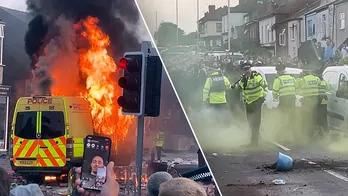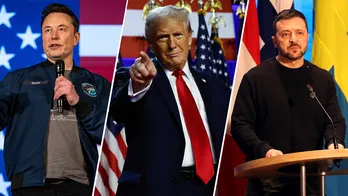An author's journey to Antarctica — and motherhood — in 'The Quickening'
Elizabeth Rush thought seeing a melting glacier might change her mind.
She wanted to be a parent, and had put those plans on hold for a year to go on an expedition to Antarctica. (Pregnant people, she learned, were not allowed to deploy to the ice on government-sponsored trips.)
"I carried my desire to have a child onto the boat with me, and it came with me to Antarctica," Rush says. "And that felt sort of terrifying because I thought I might see this massive glacier calve or break apart in front of me and that could do something to my desire to have a child."
"And it didn't," she says. "It didn't go away."
Excerpt from The Quickening: Creation and Community at the Ends of the Earth
Who knows when this all got started? When we became so tangled up in each other, in ice, in obsessing with endings already in motion and what it means to make a little life while the junk drawers overflow, and the jellyfish heap up on the shore, and the pollinator plants just keep blooming, even deep into October, long after the monarchs ought to be gone? What do we make of all that? What do we make amid all of that? Each of us begins in our own way, and yet each of us begins the same.
The year I go to Thwaites Glacier in Antarctica is also the year I decide to try to grow a human being inside of my body. It's the year of becoming two, me and you. The year we all get onto that boat, my shipmates and I, the year we sail past 73° south to the untouched edge of Thwaites is also just another year in which the ice lets go, a little more this time. Let's agree to call it a year — like the year of Magical Thinking or the Year of Living Dangerously — though let's also agree that it may not coincide with anything that resembles a year in the calendar. It will not start and stop on a certain day and there will not be 365 of anything. Instead, time will flow sideways, the way floodwaters cover the lowest land first, and it will unspool quick as a metal cable lowering a scientific instrument down to the very bottom of the Amundsen Sea.
The "Doomsday Glacier"
Rush has been covering climate change — and sea level rise in particular — for more than a decade. In that time, she's told the stories of flood survivors in coastal communities, how their lives were transformed by rising seas.
"I started to understand that there was great variability in our climate change models," Rush says. "Like, are we going to have three feet of sea level rise or six feet of sea level rise by century's end? We don't really know."
Rush resigned herself to the sensation of not knowing. But then, she learned about Thwaites.
Thwaites Glacier in Antarctica has been called the "Doomsday Glacier."
That's because — were it to disintegrate — Thwaites, roughly the size of Florida, could cause catastrophic sea level rise.
Rush wanted to see "the source of this great instability" firsthand. So she applied for a grant through the National Science Foundation that sends an artist or writer to the ice — and she got it.
Alongside 57 scientists and crew, Rush set out from Punta Arenas in southern Chile at the end of January. Crossing the Southern Ocean and the Drake Passage — which are some of the wildest seas in the world — their expedition would not arrive at the glacier until the end of February.
"We were literally the first people in Earth's history to ever make it to the place where this glacier discharges ice into the sea," Rush says.
Rush, grasping for an image, compares Thwaites to the Wall in Game of Thrones — a colossal wall of ice, ominous, its stillness broken occasionally by "some rumbling and some slumping."
"That's the only reference point I have for it,"Rush says, laughing. "It was unlike anything I'd ever seen before."
The quiet collapse
After five days of sailing beneath the looming face of the glacier, Rush and her crewmates became aware that they'd been present for an event so massive that they'd failed to recognize it. Satellite images showed that wide open waters they had sailed through on their way in were now cluttered with huge icebergs.
"And that's when it dawned on me that a really significant piece of the ice shelf had collapsed all around us," Rush says.
"I think that that's a sensation that we all know really well. None of us have lived through accelerated climate change. And so it's happening all around us, but it's really hard to put our finger on it."
This week, on The Sunday Story, author Elizabeth Rush discusses the book that emerged from her journey to Thwaites Glacier in Antarctica.
A different story of Antarctica
The first recorded sighting of Antarctica was in January 1820, Rush points out.
So every single first-person account has been written in just the past two centuries.
Many of those accounts, Rush says, revolve around narratives of conquest.
"They often show a single, exceptional man, venturing forth and conquering Antarctica's broad white bosom, its impenetrable interior," Rush says. "So there's all this language of conquest, and sexual conquest, tied up in the stories that we tell about Antarctica."
Rush says she wanted to tell a different story — a collective story told through multiple perspectives. She sees The Quickening as having 34 narrators, of whom she's just one.
"None of us goes to Antarctica alone," Rush says. " We go in community, with the support of others, both on the mission and at home."
Rush says women and people of color who, for much of history, have been excluded from Antarctic missions. She hopes that her book can be a step forward in expanding the Antarctic narrative.
Enduring the apocalypse
"For many people, this moment of facing a certain kind of end time, which we most certainly are facing — like worlds are ending all around us — I think that that feels inherently overwhelming and scary," Rush says.
After the expedition, Rush gets pregnant. She emphasizes that her choice will not be everyone's. And that's okay, she says.
But when asked where she sees hope for our future, Rush points to human history:
"There are many people on this planet who have lived through many different kinds of endings before. I think of the indigenous inhabitants of the Americas — their worlds have been ending for five centuries. And at some level, of course, climate change is a different scale of transition. But I also think that these kinds of earth transformations have happened before, and there's a lot of wisdom in how to survive them."
Audio and digital for this piece were edited by Jacob Conrad.
Disclaimer: The copyright of this article belongs to the original author. Reposting this article is solely for the purpose of information dissemination and does not constitute any investment advice. If there is any infringement, please contact us immediately. We will make corrections or deletions as necessary. Thank you.







